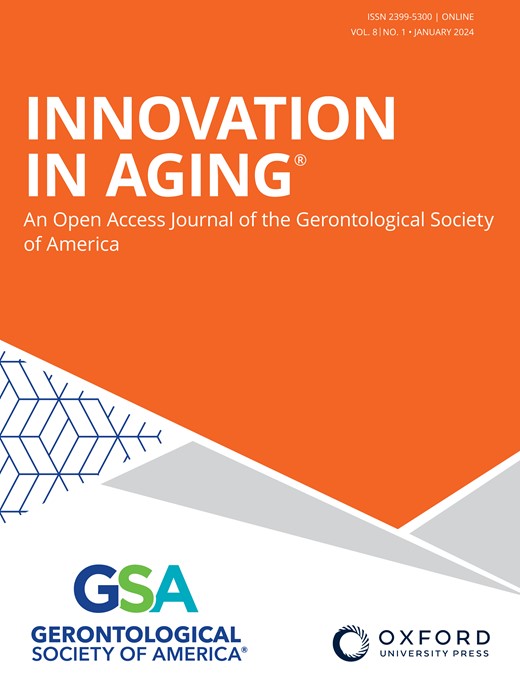对人类长寿队列的前瞻性多组学分析确定了与长寿相关的分析物网络
IF 4.9
3区 医学
Q1 GERIATRICS & GERONTOLOGY
引用次数: 0
摘要
摘要 长期以来,人们一直在寻找基于血清的长寿生物标志物来解释健康衰老和长寿的机制。长寿联合会采用 1:3 的病例队列设计,从四个队列的血清中获得了基于非靶向质谱的蛋白质组和代谢组数据集,这四个队列均为长寿队列,长寿队列的定义是:根据特定性别和出生队列的特定存活百分位数,达到与存活百分位数第 98 位相对应的年龄的人。这些队列包括男性骨质疏松性骨折研究、骨质疏松性骨折研究、健康、衰老和身体成分研究以及心血管健康研究。在这项研究中,我们利用机器学习和系统生物学方法整合了代谢组学和蛋白质组学,构建了预测长寿和健康衰老的多组学特征。我们确定了富含以前证明与长寿相关的生物标志物(如脂蛋白)的网络,以及新的关联,并进一步比较了我们在小鼠 omics LC 数据集中发现的延长寿命干预措施诱导的分子变化。我们显示了男性和女性长寿网络之间的巨大差异。这项研究强调了使用综合系统生物学方法捕捉潜在分子衰老表型异质性的有效性,从而生成可靠的长寿特征。确定的生物标志物特征可能对开发旨在促进健康老龄化和预防老年相关疾病的个性化干预措施具有重要意义。本文章由计算机程序翻译,如有差异,请以英文原文为准。
PROSPECTIVE MULTI-OMIC ANALYSIS OF HUMAN LONGEVITY COHORTS IDENTIFIES ANALYTE NETWORKS ASSOCIATED WITH LONGEVITY
Abstract Serum based biomarkers of longevity have long been sought to explain the mechanisms of healthy aging and longevity. Using a 1:3 case cohort design, the Longevity Consortium has produced untargeted mass spectrometry based proteomic and metabolomic datasets from serum of four cohorts with longevity status, defined as those that reached the age corresponding to the 98th percentile of survival using sex specific and birth cohort specific survival percentiles. The cohorts are the Osteoporotic Fractures in Men study, the Study of Osteoporotic Fractures, the Health, Aging, and Body Composition Study, and the Cardiovascular Health Study. In this study, we integrate metabolomics and proteomics using machine learning and system biology approaches to construct multi-omic signatures predictive of longevity and healthy aging. We identify networks enriched for biomarkers previously shown to be associated with longevity such as apolipoproteins, along with novel associations, and we further compare with our findings in a mouse omics LC dataset of molecular changes induced by life-extending interventions. We show substantial differences between male and female longevity networks. The study highlights the effectiveness of using integrative systems biology methods to capture the heterogeneity of underlying molecular aging phenotypes, in order to generate a robust signature of longevity. The identified biomarker signatures may have significant implications for the development of personalized interventions aimed at promoting healthy aging and preventing age-related diseases.
求助全文
通过发布文献求助,成功后即可免费获取论文全文。
去求助
来源期刊

Innovation in Aging
GERIATRICS & GERONTOLOGY-
CiteScore
4.10
自引率
0.00%
发文量
72
审稿时长
15 weeks
期刊介绍:
Innovation in Aging, an interdisciplinary Open Access journal of the Gerontological Society of America (GSA), is dedicated to publishing innovative, conceptually robust, and methodologically rigorous research focused on aging and the life course. The journal aims to present studies with the potential to significantly enhance the health, functionality, and overall well-being of older adults by translating scientific insights into practical applications. Research published in the journal spans a variety of settings, including community, clinical, and laboratory contexts, with a clear emphasis on issues that are directly pertinent to aging and the dynamics of life over time. The content of the journal mirrors the diverse research interests of GSA members and encompasses a range of study types. These include the validation of new conceptual or theoretical models, assessments of factors impacting the health and well-being of older adults, evaluations of interventions and policies, the implementation of groundbreaking research methodologies, interdisciplinary research that adapts concepts and methods from other fields to aging studies, and the use of modeling and simulations to understand factors and processes influencing aging outcomes. The journal welcomes contributions from scholars across various disciplines, such as technology, engineering, architecture, economics, business, law, political science, public policy, education, public health, social and psychological sciences, biomedical and health sciences, and the humanities and arts, reflecting a holistic approach to advancing knowledge in gerontology.
 求助内容:
求助内容: 应助结果提醒方式:
应助结果提醒方式:


